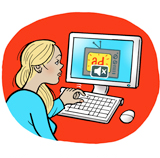 Hear that? It’s the sound of Google quietly mentioning that it plans to report on audibility for video ads at some point later this year.
Hear that? It’s the sound of Google quietly mentioning that it plans to report on audibility for video ads at some point later this year.
The audibility reference was buried as a footnote toward the end of a larger update on Google’s intention to roll out viewability reporting across all of its ad platforms, including Google Display Network, DoubleClick and YouTube.
Google has been particularly vocal on the viewability front the past several months. At the beginning of December, Google released a benchmark study which found that roughly 56% of all impressions on the GDN aren’t viewable. [Related AdExchanger comic.]
But it’s video that’s taking center stage now. In a blog post Tuesday, Neal Mohan, Google’s SVP of video and display advertising, called YouTube’s growth rate “stunning,” noting that “more video content will be uploaded today than all three major networks created in the past five years.”
The debate around ad viewability continues to swirl – and several large brands and agencies have been vocal about their displeasure with the IAB’s existing standards – but when it comes down to it, viewability without audibility doesn’t make much sense.
As David Hahn, head of product management at Integral Ad Science, put it: “In order for an ad to be viewable, a video needs to meet certain criteria. Audibility, whether an ad is autoplay, how much of an ad was in-view and for what duration – these are not mutually exclusive things. Video audibility and viewability are part and parcel of the same discussion, just like viewability and fraud are now part of the same discussion.”
And that discussion is edging its way more deeply into a dialogue on quality.
“With online video audibility, measurement is a key element to understanding the overall quality of the impression an advertiser buys,” said DoubleVerify chief operating officer Matt McLaughlin. “We work with agencies who include the audibility component into the media-buying contracts they have with advertisers. Although it’s not part of baseline agreements, advertisers already view audibility as an important component.”
But greater overall transparency will likely do more for the industry than a single standard, Hahn said. From there, media quality – and commensurate prices for certain impressions over others – will follow.
“Then it becomes less about certification and more about a business transaction. It also becomes more effective to transact in an RTB marketplace if we can give an advertiser more information on whether certain ads have a higher chance of being seen for a certain amount of time with sound than other ads,” Hahn said. “The MRC and the industry will rally around the notion that video ads should be sound-on, which relates to the debate around publishers getting credit for muted ads that aren’t in-view. The discussion around audibility revolves around making sure an ad always plays on-screen.”
Of course, there are technical challenges. For example, both the video player and the device itself have volume controls, and detecting mute on a device is extremely difficult. It’s also impossible to know whether users have their headphones plugged in sitting next to their keyboard rather than on or in their ears. But that sort of thing is true in the TV world as well, where some people consider commercial breaks to be synonymous with “time to visit the bathroom.”
AdExchanger Daily
Get our editors’ roundup delivered to your inbox every weekday.
Daily Roundup
“There are things we can control and measure and things we cannot, but my feeling is that the MRC will ultimately mandate that audio has to be on for an ad to count as viewable and we support that,” Hahn said. “Just look at viewability and fraud. If an ad is served to a bot in-view, does that count as a viewed ad? Absolutely not. Viewability and audibility will become inextricably linked in the same way viewability and fraud have become linked.”
In terms of what Google’s planning to do on the audibility front, only Google knows, but it’s clear that it has video – and brands – on the brain.
“Advertisers are spending more on online video and they’re looking for a full set of metrics around video, and that includes audibility, whether a video was user-initiated or autoplay and what environment it appears in,” McLaughlin said.
Back in July, David Lowsky, a Google product manager, told AdExchanger that audibility “likely will not be incorporated in Active View’s definition of a viewable ad impression, nor required by the MRC’s viewable definition, at launch. But we are exploring ways that it may be incorporated in the future.”
Now that seems to be bearing out.
“Google is definitely trying to improve the value of YouTube and help advertisers understand that value,” Hahn said. “That’s why audio is becoming a much bigger component here.”














